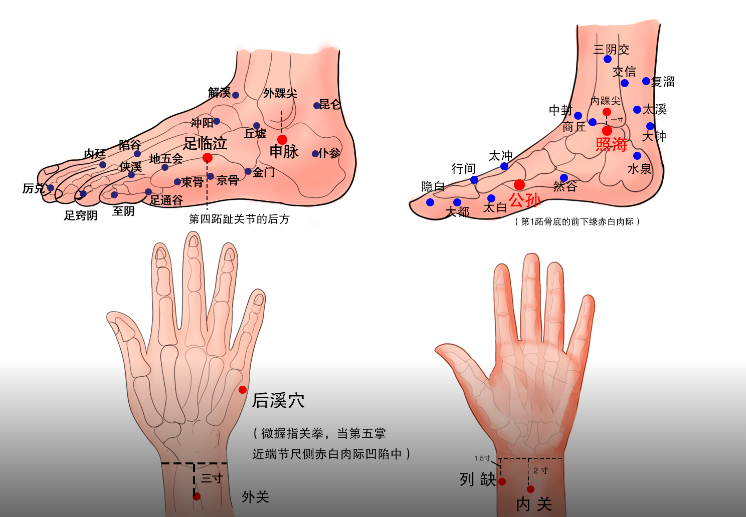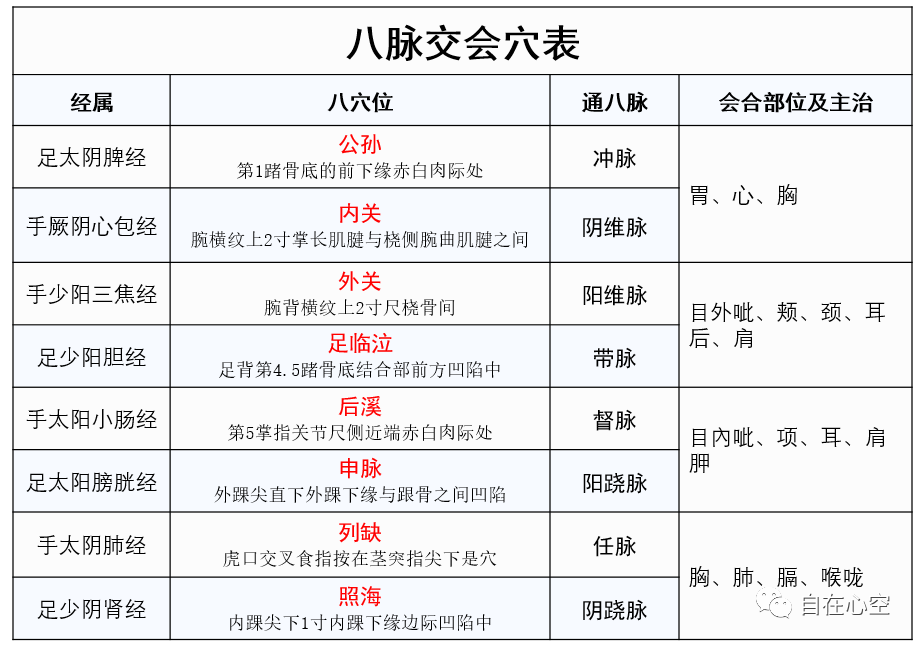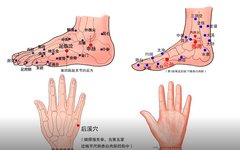| Acupuncture points, commonly known as “points“, are special locations on the body where the qi of the internal organs and meridians is infused into the surface. The term “腧” (shù) relates to the meaning of transmission and infusion, while “穴” (xué) means a hole or opening. There are many acupuncture points in the human body, which can generally be divided into three categories: the fourteen meridian points, extraordinary points, and Ah Shi points.
Some acupuncture points are referred to as “specific points“, which are special therapeutic points among the fourteen meridian points, summarized under specific titles. Based on their different distribution characteristics, meanings, and therapeutic effects, they are categorized into “Five Shu Points“, “Yuan Points”, “Luo Points”, “Shu Points“, “Mu Points”, “Eight Meeting Points“, “Xie Points”, “Lower He Points”, “Eight Meridians Intersection Points”, and “Intersection Points“. |
Eight Meridians Intersection Points, also known as “Flowing Eight Points” or “Intersecting Eight Points”, refer to the eight acupuncture points where the Eight Extraordinary Meridians connect with the qi of the twelve regular meridians, all located near the wrists and ankles, primarily treating conditions related to the extraordinary meridians. The eight points include Gong Sun (公孙), Nei Guan (内关), Wai Guan (外关), Zu Lin Qi (足临泣), Zhao Hai (照海), Lie Que (列缺), Shen Mai (申脉), and Hou Xi (后溪).

The Eight Meridians Intersection Points were first mentioned in Song Zihua’s “Flowing Eight Points”, later compiled by Dou Hanqing in the book “Guide to Acupuncture Classics”. Due to Dou’s adept use of these eight points, they gained popularity, and thus were later referred to as “Dou’s Eight Points”. In Dou Hanqing’s “Guide to Acupuncture Classics”, the locations, meridian affiliations, needling methods, and clinical applications of the eight points are detailed, playing a significant role in their transmission and development in later generations.

The eight meridians refer to the Eight Extraordinary Meridians, namely Ren (任), Du (督), Chong (冲), Dai (带), Yin Wei (阴维), Yang Wei (阳维), Yin Qiao (阴蹻), and Yang Qiao (阳蹻). The eight specific acupuncture points where these extraordinary meridians intersect with the twelve regular meridians are called the Eight Meridians Intersection Points. The term “交” (jiāo) implies communication and intersection; “会” (huì) means gathering and meeting. Intersection points refer to acupuncture points where two or more meridians communicate and intersect. The Eight Extraordinary Meridians communicate with the qi of the twelve regular meridians through the Eight Meridians Intersection Points. The specific intersections are as follows:
1. The Gong Sun point of the Foot Taiyin Spleen Meridian connects with the Chong Meridian, and the Nei Guan point of the Hand Jueyin Pericardium Meridian connects with the Yin Wei Meridian, both converging at the heart, stomach, and chest area; 2. The Wai Guan point of the Hand Shaoyang Sanjiao Meridian connects with the Yang Wei Meridian, and the Zu Lin Qi point of the Foot Shaoyang Gallbladder Meridian connects with the Dai Meridian, both converging at the outer canthus of the eye and shoulder area; 3. The Hou Xi point of the Hand Taiyang Small Intestine Meridian connects with the Du Meridian, and the Shen Mai point of the Foot Taiyang Bladder Meridian connects with the Yang Qiao Meridian, both converging at the inner canthus of the eye and scapular area; 4. The Lie Que point of the Hand Taiyin Lung Meridian connects with the Ren Meridian, and the Zhao Hai point of the Foot Shaoyin Kidney Meridian connects with the Yin Qiao Meridian, both converging at the throat, lung, and chest diaphragm area.

Among these eight points, only Shen Mai and Zhao Hai are the direct intersection points of the Foot Taiyang Bladder Meridian with the Yang Qiao and the Foot Shaoyin Kidney Meridian with the Yin Qiao, while the other six points do not directly intersect with the extraordinary meridians at their locations but communicate through their affiliated meridians at other body parts, thus they are meridian intersections leading to point communication. Dou referred to the eight points as “Intersecting Eight Points”, which better reflects the communication method of these points.

1. Therapeutic Functions The therapeutic range of the Eight Meridians Intersection Points is very broad; the book “Guide to Acupuncture Classics” records over 200 main symptoms, determined by the uniqueness of the eight points. Each point corresponds to a regular meridian and an extraordinary meridian, forming extensive connections with other organs, meridians, and tissues. Therefore, needling and moxibustion at these eight points can regulate the twelve regular meridians and the Eight Extraordinary Meridians.2. Treated Conditions1. Treat conditions related to the corresponding regular meridians and associated organs and meridians.2. Treat conditions of the extraordinary meridians. The Eight Extraordinary Meridians have specific pathways and symptoms, connecting the twelve meridians, playing a role in accumulating and nourishing the qi and blood of the twelve meridians. Since six of these meridians do not have corresponding acupuncture points, when the extraordinary meridians are affected, the Eight Meridians Intersection Points can be selected for treatment. 3. Single Point Treatment Range(1) Gong Sun: A point of the Foot Taiyin Spleen Meridian, connecting with the Foot Yangming Stomach Meridian and the Chong Meridian. It regulates qi, strengthens the spleen, harmonizes the stomach, and descends rebellious qi. Its therapeutic range relates to the pathways and symptoms of the Foot Taiyin Spleen Meridian, Foot Yangming Stomach Meridian, Foot Taiyin Luo Meridian, and Chong Meridian, as well as other related meridians, organs, and tissues. It can treat conditions such as spleen and stomach disorders, liver and gallbladder diseases, mental disorders, heart and lung issues, women’s diseases, and conditions of the limbs and skin. (2) Nei Guan: A point of the Hand Jueyin Pericardium Meridian, connecting with the Hand Shaoyang Sanjiao Meridian and the Yin Wei Meridian. It harmonizes blood, promotes qi circulation, relieves pain, and calms the mind. Its therapeutic range relates to the pathways and symptoms of the Hand Jueyin Pericardium Meridian, Hand Shaoyin Heart Meridian, Hand Shaoyang Sanjiao Meridian, Hand Jueyin Luo Meridian, and Yin Wei Meridian, making it a key point for treating heart and chest diseases. It can treat conditions such as heart issues, mental disorders, spleen and stomach disorders, liver and gallbladder diseases, lung issues, women’s diseases, and conditions of the limbs and skin. (3) Lie Que: A point of the Hand Taiyin Lung Meridian, connecting with the Hand Yangming Large Intestine Meridian and the Ren Meridian. It promotes lung qi and regulates the meridians. Its therapeutic range relates to the pathways and symptoms of the Hand Taiyin Lung Meridian, Hand Taiyin Luo Meridian, Hand Yangming Large Intestine Meridian, and Ren Meridian, as well as other related meridians, organs, and tissues. It can treat conditions such as lung issues, mental disorders, spleen and stomach disorders, bladder and kidney diseases, women’s diseases, and conditions of the limbs and skin. (4) Zhao Hai: A point of the Foot Shaoyin Kidney Meridian, connecting with the Yin Qiao Meridian. It tonifies the kidneys and nourishes essence, regulating the Yin Qiao. Its therapeutic range relates to the pathways and symptoms of the Foot Shaoyin Kidney Meridian and the Yin Qiao Meridian, as well as other related organs, meridians, and tissues. It can treat conditions such as kidney and bladder diseases, mental disorders, conditions of the limbs and skin, heart and lung issues, spleen and liver diseases, and women’s diseases. (5) Wai Guan: A point of the Hand Shaoyang Sanjiao Meridian, connecting with the Hand Jueyin Pericardium Meridian and the Yang Wei Meridian. The Yang Wei Meridian governs all Yang and is responsible for exterior conditions. Its therapeutic range relates to the pathways and symptoms of the Sanjiao Meridian, Pericardium Meridian, Hand Shaoyang Luo Meridian, and Yang Wei Meridian, as well as other related meridians, organs, and tissues. It can treat conditions such as skin issues of the limbs, mental disorders, conditions of the limbs and skin, and spleen and stomach disorders. (6) Zu Lin Qi: A point of the Foot Shaoyang Gallbladder Meridian, connecting with the Dai Meridian. Its therapeutic range relates to the pathways and symptoms of the Gallbladder Meridian and the Dai Meridian, as well as other related meridians, organs, and tissues. It can treat conditions such as skin issues of the limbs, conditions of the limbs and skin, women’s diseases, mental disorders, and kidney and bladder diseases, as well as liver and gallbladder diseases. (7) Hou Xi: A point of the Hand Taiyang Small Intestine Meridian, connecting with the Du Meridian. Its therapeutic range relates to the pathways and symptoms of the Hand Taiyang Small Intestine Meridian and the Du Meridian, as well as other related meridians, organs, and tissues. It can treat conditions such as mental disorders, skin issues of the limbs, and conditions of the limbs and skin. (8) Shen Mai: A point of the Foot Taiyang Bladder Meridian, connecting with the Yang Qiao. Its therapeutic range relates to the pathways and symptoms of these two meridians, as well as other related meridians, organs, and tissues. It can treat conditions such as mental disorders and muscle and tendon issues. 4. Combination Treatment Range In clinical practice, the eight points are often paired up, divided into four groups for use, which can change the bias of single point usage, enhance synergistic effects, and make clinical efficacy more significant, reflecting the characteristics of holistic treatment. The combinations and their therapeutic ranges are as follows: (1) Gong Sun ~ Nei Guan combined has the effects of regulating qi, descending rebellious qi, promoting digestion, and harmonizing the stomach. It is commonly used for heart, chest, spleen, and liver disorders, such as palpitations, chest tightness, abdominal distension, vomiting, and diarrhea. (2) Zu Lin Qi ~ Wai Guan combined has the effects of clearing the head and eyes, benefiting the chest and sides, regulating qi and meridians, and dispersing exterior pathogens. It is commonly used for conditions of the outer canthus of the eye, ear, cheek, neck, shoulder, and side of the body, as well as conditions caused by external wind pathogens, such as eye swelling, eye pain, tinnitus, deafness, migraines, intercostal neuralgia, and exterior cold-heat conditions. (3) Shen Mai ~ Hou Xi combined has the effects of calming the mind, clearing the head and eyes, and promoting meridian circulation. It is commonly used for conditions of the inner canthus of the eye, neck, nape, ear, and shoulder, as well as Taiyang meridian conditions, heart, liver, and brain disorders, such as stroke, hemiplegia, lumbar and knee pain, conditions caused by wind, cold, and dampness, convulsions, headaches, dizziness, insomnia, epilepsy, and hysteria. (4) Zhao Hai ~ Lie Que combined has the effects of regulating lung qi, benefiting kidney qi, calming the mind, and clearing empty heat. It is commonly used for lung, throat, chest, liver, heart, and kidney disorders, such as sore throat, difficulty swallowing, loss of voice, speech difficulties, cough, chest fullness, yin deficiency with internal heat, insomnia, epilepsy, hysteria, and difficulty urinating.
| Dou Hanqing summarized the therapeutic range of the Eight Meridians Intersection Points in his “Medical Primer”: “The Yang Qiao, Yang Wei, and Du meridians govern diseases of the shoulder, back, waist, and legs; the Yin Qiao, Yin Wei, Ren, and Chong meridians govern diseases of the heart, abdomen, and ribs.” Here, Yang Qiao refers to the Shen Mai point, which connects with the Yang Qiao Meridian, Yang Wei refers to the Wai Guan point, which connects with the Yang Wei Meridian, Du refers to the Hou Xi point, which connects with the Du Meridian, and Dai refers to the Zu Lin Qi point, which connects with the Dai Meridian. These four points are primarily used to treat exterior meridian diseases, such as shoulder, back, waist, and leg disorders. Conversely, the Zhao Hai, Nei Guan, Lie Que, and Gong Sun points, which connect with the Yin Qiao, Yin Wei, Ren, and Chong meridians, are primarily used to treat internal organ diseases. Similarly, the Yin Qiao refers to the Zhao Hai point, the Yin Wei refers to the Nei Guan point, the Ren refers to the Lie Que point, and the Chong refers to the Gong Sun point, which are primarily used to treat internal diseases of the stomach, heart, and chest. This is a high-level summary of the therapeutic range of the Eight Meridians Intersection Points. |
The importance of the Eight Meridians Intersection Points is highlighted by Li Ting in his “Introduction to Medicine”: “There are 365 acupuncture points throughout the body, governed by 66 points on the hands and feet, and these 66 points are further governed by the eight points”, indicating that the Eight Meridians Intersection Points can treat diseases throughout the body, with a broad therapeutic range. Ming dynasty physician Wu Kun stated: “By intersecting the Eight Extraordinary Meridians, the eight points govern diseases of the exterior, interior, and between exterior and interior.” Zhang Zhongjing excelled in treating cold damage due to his understanding of the six meridians; I now consider the eight methods to be excellent because they govern the eight meridians while encompassing the twelve meridians, creating a significant method in acupuncture and moxibustion…”.3. Point Pairing Methods1. Bilateral Upper and Lower Point Selection: This is the most commonly used pairing method in clinical practice, applicable in various situations, and yields good results. 2. Unilateral Upper and Lower Point Selection: This is used for exterior meridian diseases of the waist, back, and limbs, particularly on one side, such as back pain, various sprains, post-stroke hemiplegia, and polio, where a single side’s upper and lower points can be selected. 3. Cross-Side Upper and Lower Point Selection: This is suitable for various head and face conditions, internal organ diseases, and for patients who fear needles, are weak, or are mentally tense, where it is necessary to select points on both sides to adjust the whole body.

